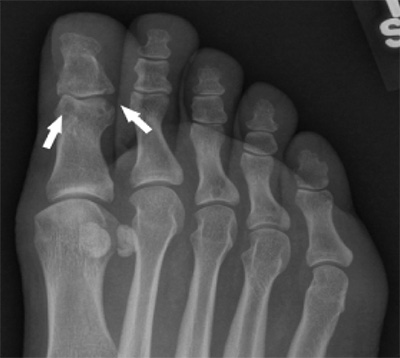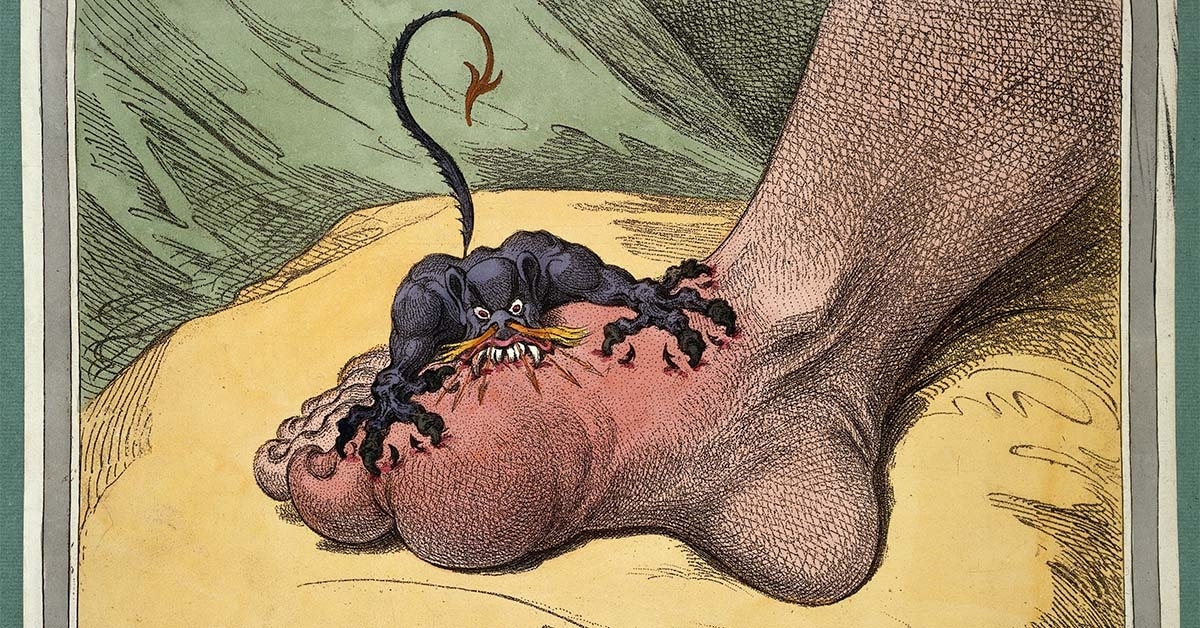New Look at an Ancient Disease: Study Finds Novel Treatment Targets for Gout
UC San Diego scientists identify a new model of the arthritic disease, centered on the joint lubricating protein lubricin
Story by:
Published Date
Article Content
Many Americans think of gout as a disease from a bygone era, akin to rickets or scurvy. The condition commonly afflicted the rich and royal, including American historical figures such as Benjamin Franklin and Thomas Jefferson.
Gout is indeed one of the earliest known diseases, first identified by the ancient Egyptians around 2640 BC. But the disease is more prevalent now than ever, affecting more than 10 million people in the United States or approximately 5 percent of the adult population.
Gout is the most common form of inflammatory arthritis, in which urate (a byproduct of purine-rich foods like meat and alcohol) builds up in the body and forms needle-shaped crystals in and around the joints, usually starting in the foot. The crystal deposits lead to flares of severe pain, joint swelling and tenderness, and can progress to chronic joint damage that limits patients’ movement and quality of life.
Excess urate circulating in the blood (known as hyperuricemia) has long been considered the major cause of gout, but counterintuitively, most people with high urate levels do not actually develop the disease. In fact, asymptomatic hyperuricemia is approximately four times more prevalent than gout. Gout patients also show mysteriously higher levels of urate in their joint fluid compared to their blood. Thus hyperuricemia must not be the only thing stimulating urate crystal deposition in the joints. So what else could be causing the disease?
In a new study published online on December 1, 2022 in Arthritis & Rheumatology, an international research team led by University of California San Diego School of Medicine identified a novel molecular pathway that causes gout and its progression to joint tissue erosion. The findings position lubricin, a protein found in joint fluid, as a novel therapeutic target for both the prevention and treatment of the disease.
The scientists were interested in exploring the genetic factors that lead not to high levels of circulating urate, but specifically to urate production and crystal deposition within joints. To do this, they studied a rare case of gout in which the patient had developed urate crystal deposits and erosion in her joints but did not show high levels of urate in her blood.
“This naturally occurring and extremely unusual disorder provided a unique opportunity to look at gouty arthritis through a different lens, and understand what molecular processes contribute to the disease independent of hyperuricemia,” said senior author Robert Terkeltaub, MD, professor at UC San Diego School of Medicine and section chief of Rheumatology at the Veterans Affairs San Diego Healthcare System.
“Our findings show that lubricin may be a new biomarker for tracing patients’ risk of developing gout, and that new drugs to maintain and increase lubricin could limit the incidence and progression of gouty arthritis.”

Using whole genome sequencing, RNA-sequencing and quantitative proteomic methods, the researchers were able to identify a major molecular pathway that was disrupted in the patient, centering on a significant reduction in lubricin. The mucinous protein provides essential lubrication and protection to joint tissues, and regulates the function of a specific type of white blood cell that promotes inflammation in the joint.
Additional experiments confirmed that under healthy conditions, lubricin suppresses the secretion of urate and xanthine oxidase (an enzyme that produces urate) by activated white blood cells, and also blocks urate from crystallizing in the joint. The researchers then assessed several patients with the common form of gout and confirmed that they too had markedly decreased levels of lubricin.
The authors suggest that whether or not a hyperacemia patient goes on to develop gout may thus be influenced by which gene variants they have for lubricin and other molecules that control its production or degradation in the joint.
“Our findings show that lubricin may be a new biomarker for tracing patients’ risk of developing gout, and that new drugs to maintain and increase lubricin could limit the incidence and progression of gouty arthritis,” said Terkeltaub.
Co-authors include: Leigh-Ana Rossitto, Ru LiuBryan, Majid Ghassemian, Anaamika Campeau and David J. Gonzalez at UC San Diego; Marin Miner at Veterans Affairs San Diego Healthcare System; Khaled Elsaid and Sandy Elsayed at Chapman University; Amanda Phipps-Green, Tony R. Merriman and Murray Cadzow at University of Otago; Jacob Karsh at University of Ottawa; Gregory D. Jay at Rhode Island Hospital; Marwa Qadri at Jazan University; Talia J. Dambruoso at Brown University; Tannin Schmidt at University of Connecticut Health Center; Nicola Dalbet and Ashika Chhana at University of Auckland; Jennifer Höglund at University of Gothenburg; Nancy Maltez at Ottawa Riverside Hospital; and Niclas G. Karlsson at Oslo Metropolitan University.
The study was funded, in part, by the National Institutes of Health (grants T32 GM007752TRM, T32 AR064194, AR075990, AR067748, AR075990, PAG007996), the VA Research Service (grants I01 BX002234 and I01 BX005927), the Health Research Council of New Zealand (grants 14-527, 19-232), the Rheumatology Research Foundation Innovation Research Award, the Royal Society of New Zealand Rutherford Foundation Post-Doctoral Research Fellowship, the Swedish state under the agreement between the Swedish government and the county council, the ALF-agreement (ALFGBG-722391), the Swedish Research Council (621-2013-5895), the Petrus and Augusta Hedlunds Foundation (M-2016-0353), the AFA Insurance Research Fund (dnr 150150) and the UCSD Collaborative Center of Multiplexed Proteomics.
Disclosures: Robert Terkeltaub has served as a consultant for Dyve Biosciences, Fortress Bio, Allena and Acquist; Nicola Dalbet has served as a consultant for AstraZeneca, Dyve Biosciences, Horizon, Amgen, Selecta, Arthrosi, JW Pharmaceutical Corporation, PK Med, PTC Therapeutics and Protalix; Khaled Elsaid holds a patent on the use of rhPRG4 for treatment of acute gout; Tannin Schmidt has authored patents on rhPRG4 and is a paid consultant and holds equity in Lubris LLC; Gregory D. Jay has authored patents on lubricin and holds equity in Lubris LLC; Niclas G. Karlsson has authored a patent on lubricin as a biomarker and holds equity in Lynxon AB.
Share This:
You May Also Like
Stay in the Know
Keep up with all the latest from UC San Diego. Subscribe to the newsletter today.




